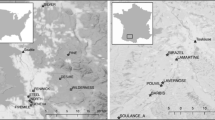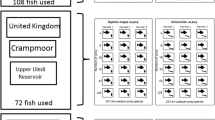Abstract
Intraspecific trait variability is now well recognized as a key component of biodiversity explaining how individuals within a species can differentially interact with their environment. To date, however, this concept has rarely been incorporated in the study of biological invasions, despite its provision of new insights into invasive species management. Here, we used an experimental approach to investigate how invasive red swamp crayfish (Procambarus clarkii) derived from geographically close ecosystems can differentially impact prey community structure and relevant ecosystem processes. We also compared the magnitude of the effects induced by invasive species introduction with those induced by intraspecific variability. Our results showed that effects of intraspecific variability can be strong for direct interactions such as resource (e.g., leaf litter, snails) consumption and of similar magnitude to the effects induced by the introduction of the invasive species when considering indirect interactions (e.g., primary production, ecosystem metabolism). Overall, these results highlighted that invasive populations of the same species are not ecologically equivalent, with each population acting differently on their recipient ecosystem.


Similar content being viewed by others
References
Alp M, Cucherousset J, Buoro M, Lecerf A (2016) Phenological response of a key ecosystem function to biological invasion. Ecol Lett 19:519–527. https://doi.org/10.1111/ele.12585
Araújo MS, Bolnick DI, Layman CA (2011) The ecological causes of individual specialisation: the causes of individual specialisation. Ecol Lett 14:948–958. https://doi.org/10.1111/j.1461-0248.2011.01662.x
Biro PA, Adriaenssens B, Sampson P (2014) Individual and sex-specific differences in intrinsic growth rate covary with consistent individual differences in behaviour. J Anim Ecol 83:1186–1195. https://doi.org/10.1111/1365-2656.12210
Bolnick DI, Amarasekare P, Araújo MS et al (2011) Why intraspecific trait variation matters in community ecology. Trends Ecol Evol 26:183–192. https://doi.org/10.1016/j.tree.2011.01.009
Brandner J, Cerwenka AF, Schliewen UK, Geist J (2013) Bigger is better: characteristics of round gobies forming an invasion front in the Danube River. PLoS One 8:e73036. https://doi.org/10.1371/journal.pone.0073036
Britton JR, Gozlan RE, Copp GH (2011) Managing non-native fish in the environment: managing non-native fishes. Fish Fish 12:256–274. https://doi.org/10.1111/j.1467-2979.2010.00390.x
Changeux T (2003) Évolution de la répartition des écrevisses en France métropolitaine selon les enquêtes nationales menées par le conseil supérieur de la pêche de 1977 à 2001. Bull Français de la Pêche et de la Pisciculture 370–371:15–41. https://doi.org/10.1051/kmae:2003002
Chapple DG, Simmonds SM, Wong BBM (2012) Can behavioral and personality traits influence the success of unintentional species introductions? Trends Ecol Evol 27:57–64. https://doi.org/10.1016/j.tree.2011.09.010
Clavero M, García-Berthou E (2005) Invasive species are a leading cause of animal extinctions. Trends Ecol Evol 20:110. https://doi.org/10.1016/j.tree.2005.01.003
Costa-Pereira R, Rudolf VHW, Souza FL, Araújo MS (2018) Drivers of individual niche variation in coexisting species. J Anim Ecol. https://doi.org/10.1111/1365-2656.12879
Cote J, Fogarty S, Weinersmith K et al (2010) Personality traits and dispersal tendency in the invasive mosquitofish (Gambusia affinis). Proc R Soc B Biol Sci 277:1571–1579. https://doi.org/10.1098/rspb.2009.2128
Cote J, Brodin T, Fogarty S, Sih A (2017) Non-random dispersal mediates invader impacts on the invertebrate community. J Anim Ecol 86:1298–1307. https://doi.org/10.1111/1365-2656.12734
Cucherousset J, Olden JD (2011) Ecological impacts of nonnative freshwater fishes. Fisheries 36:215–230. https://doi.org/10.1080/03632415.2011.574578
Des Roches S, Post DM, Turley NE et al (2018) The ecological importance of intraspecific variation. Nat Ecol Evol 2:57–64. https://doi.org/10.1038/s41559-017-0402-5
Díaz S, Purvis A, Cornelissen JHC et al (2013) Functional traits, the phylogeny of function, and ecosystem service vulnerability. Ecol Evol 3:2958–2975. https://doi.org/10.1002/ece3.601
Duckworth RA, Badyaev AV (2007) Coupling of dispersal and aggression facilitates the rapid range expansion of a passerine bird. Proc Natl Acad Sci 104:15017–15022. https://doi.org/10.1073/pnas.0706174104
Dunoyer L, Dijoux L, Bollache L, Lagrue C (2014) Effects of crayfish on leaf litter breakdown and shredder prey: are native and introduced species functionally redundant? Biol Invasions 16:1545–1555. https://doi.org/10.1007/s10530-013-0590-0
Evangelista C, Lecerf A, Britton JR, Cucherousset J (2017) Resource composition mediates the effects of intraspecific variability in nutrient recycling on ecosystem processes. Oikos 126:1439–1450. https://doi.org/10.1111/oik.03787
Forsman A (2014) Effects of genotypic and phenotypic variation on establishment are important for conservation, invasion, and infection biology. Proc Natl Acad Sci 111:302–307. https://doi.org/10.1073/pnas.1317745111
Fryxell DC, Arnett HA, Apgar TM et al (2015) Sex ratio variation shapes the ecological effects of a globally introduced freshwater fish. Proc R Soc B Biol Sci 282:20151970. https://doi.org/10.1098/rspb.2015.1970
Gherardi F, Lazzara L (2006) Effects of the density of an invasive crayfish (Procambarus clarkii) on pelagic and surface microalgae in a Mediterranean wetland. Archiv für Hydrobiologie 165:401–414. https://doi.org/10.1127/0003-9136/2006/0165-0401
González-Suárez M, Bacher S, Jeschke JM (2015) Intraspecific trait variation is correlated with establishment success of alien mammals. Am Nat 185:737–746. https://doi.org/10.1086/681105
Gruber J, Brown G, Whiting MJ, Shine R (2017) Geographic divergence in dispersal-related behaviour in cane toads from range-front versus range-core populations in Australia. Behav Ecol Sociobiol 71:38. https://doi.org/10.1007/s00265-017-2266-8
Jackson MC, Jones T, Milligan M et al (2014) Niche differentiation among invasive crayfish and their impacts on ecosystem structure and functioning. Freshw Biol 59:1123–1135. https://doi.org/10.1111/fwb.1233359
Jackson MC, Evangelista C, Zhao T et al (2017) Between-lake variation in the trophic ecology of an invasive crayfish. Freshw Biol 62:1501–1510. https://doi.org/10.1111/fwb.12957
Jokela A, Ricciardi A (2008) Predicting zebra mussel fouling on native mussels from physicochemical variables. Freshw Biol 53:1845–1856. https://doi.org/10.1111/j.1365-2427.2008.02009.x
Juette T, Cucherousset J, Cote J (2014) Animal personality and the ecological impacts of freshwater non-native species. Curr Zool 60:417–427. https://doi.org/10.1093/czoolo/60.3.417
Kumschick S, Gaertner M, Vilà M et al (2014) Ecological impacts of alien species: quantification, scope, caveats, and recommendations. Bioscience 65:55–63. https://doi.org/10.1093/biosci/biu193
Matsuzaki SS, Usio N, Takamura N, Washitani I (2009) Contrasting impacts of invasive engineers on freshwater ecosystems: an experiment and meta-analysis. Oecologia 158:673–686. https://doi.org/10.1007/s00442-008-1180-1
Mollema PN, Antonellini M (2016) Water and (bio)chemical cycling in gravel pit lakes: a review and outlook. Earth Sci Rev 159:247–270. https://doi.org/10.1016/j.earscirev.2016.05.006
Murray K, Connor MM (2009) Methods to quantify variable importance: implications for the analysis of noisy ecological data. Ecology 90:348–355. https://doi.org/10.1890/07-1929.1
Nakagawa S, Cuthill IC (2007) Effect size, confidence interval and statistical significance: a practical guide for biologists. Biol Rev 82:591–605. https://doi.org/10.1111/j.1469-185X.2007.00027.x
Oksanen AJ, Blanchet FG, Kindt R et al (2017) Vegan: community ecology package. Version 2.4–3. http://CRAN.R-project.org/package=vegan
Palkovacs EP, Fryxell DC, Turley NE, Post DM (2015) Ecological effects of intraspecific consumer biodiversity for aquatic communities and ecosystems. Aquatic functional biodiversity. Elsevier, Amsterdam, pp 37–51
Petersen RC, Cummins KW (1974) Leaf processing in a woodland stream. Freshw Biol 4:343–368. https://doi.org/10.1111/j.1365-2427.1974.tb00103.x
Phillips BL, Shine R (2006) Spatial and temporal variation in the morphology (and thus, predicted impact) of an invasive species in Australia. Ecography 29:205–212. https://doi.org/10.1111/j.2006.0906-7590.04413.x
Phillips BL, Brown GP, Webb JK, Shine R (2006) Invasion and the evolution of speed in toads. Nature 439:803. https://doi.org/10.1038/439803a
Pintor LM, Sih A, Bauer ML (2008) Differences in aggression, activity and boldness between native and introduced populations of an invasive crayfish. Oikos 117:1629–1636. https://doi.org/10.1111/j.1600-0706.2008.16578.x
R Development Core Team (2017) R: a language and environment for statistical computing. R Foundation for Statistical Computing, Vienna
Raffard A, Lecerf A, Cote J et al (2017) The functional syndrome: linking individual trait variability to ecosystem functioning. Proc R Soc B Biol Sci 284:20171893. https://doi.org/10.1098/rspb.2017.1893
Raffard A, Santoul F, Cucherousset J, Blanchet S (2018) The community and ecosystem consequences of intraspecific diversity: a meta-analysis. Biol Rev. https://doi.org/10.1111/brv.12472
Réale D, Garant D, Humphries MM et al (2010) Personality and the emergence of the pace-of-life syndrome concept at the population level. Proc Trans R Soc B Biol Sci 365:4051–4063. https://doi.org/10.1098/rstb.2010.0208
Richardson JL, Urban MC, Bolnick DI, Skelly DK (2014) Microgeographic adaptation and the spatial scale of evolution. Trends Ecol Evol 29:165–176. https://doi.org/10.1016/j.tree.2014.01.002
Ruokonen TJ, Karjalainen J, Hämäläinen H (2014) Effects of an invasive crayfish on the littoral macroinvertebrates of large boreal lakes are habitat specific. Freshw Biol 59:12–25. https://doi.org/10.1111/fwb.12242
Simberloff D, Martin J-L, Genovesi P et al (2013) Impacts of biological invasions: what’s what and the way forward. Trends Ecol Evol 28:58–66. https://doi.org/10.1016/j.tree.2012.07.013
Staehr PA, Bade D, Van de Bogert MC et al (2010) Lake metabolism and the diel oxygen technique: state of the science. Limnol Oceanogr Methods 8:628–644. https://doi.org/10.4319/lom.2010.8.0628
Steinman AD, Lamberti GA, Leavitt PR (2006) Biomass and pigments of benthic algae. Methods in stream ecology. Elsevier, Amsterdam, pp 357–379
Strayer DL (2010) Alien species in fresh waters: ecological effects, interactions with other stressors, and prospects for the future. Freshw Biol 55:152–174. https://doi.org/10.1111/j.1365-2427.2009.02380.x
Twardochleb LA, Olden JD, Larson ER (2013) A global meta-analysis of the ecological impacts of nonnative crayfish. Freshw Sci 32:1367–1382. https://doi.org/10.1899/12-203.1
Violle C, Enquist BJ, McGill BJ et al (2012) The return of the variance: intraspecific variability in community ecology. Trends Ecol Evol 27:244–252. https://doi.org/10.1016/j.tree.2011.11.014
Závorka L, Buoro M, Cucherousset J (2018a) The negative ecological impacts of a globally introduced species decrease with time since introduction. Glob Change Biol 24:4428–4437. https://doi.org/10.1111/gcb.14323
Závorka L, Lang I, Raffard A et al (2018b) Importance of harvest-driven trait changes for the management of invasive species. Front Ecol Environ 16:317–318. https://doi.org/10.1002/fee.1922
Zhao T, Grenouillet G, Pool T et al (2016) Environmental determinants of fish community structure in gravel pit lakes. Ecol Freshw Fish 25:412–421. https://doi.org/10.1111/eff.12222
Acknowledgements
We are very grateful to Serge Boutes for access to the experiment site, and to Maria Alp, Rémy Lassus, Carine Rigolet and Libor Závorka for their help during the experiment. We also thank two anonymous reviewers and editors for their constructive comments on previous version of the manuscript.
Funding
This work was supported by the ONEMA (Projets ISOLAC and ERADINVA) and a PRES-Toulouse Grant (Inva_Eco_Evo_Lac).
Author information
Authors and Affiliations
Contributions
CE, AL and JC conceived and designed the experiment. CE led the experiment. CE and AL performed the statistical analyses. CE, AL and JC wrote the manuscript.
Corresponding author
Ethics declarations
Conflict of interest
The authors declare that they have no conflict of interest.
Ethics
Authorizations to perform this study were provided by the “Arrêté Préfectoral—from 18/09/2015 to 30/10/2015”.
Additional information
Communicated by Leon A. Barmuta.
Electronic supplementary material
Below is the link to the electronic supplementary material.
Rights and permissions
About this article
Cite this article
Evangelista, C., Cucherousset, J. & Lecerf, A. Contrasting ecological impacts of geographically close invasive populations. Oecologia 189, 529–536 (2019). https://doi.org/10.1007/s00442-018-04333-5
Received:
Accepted:
Published:
Issue Date:
DOI: https://doi.org/10.1007/s00442-018-04333-5




